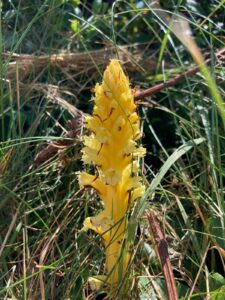2021 County Report for Pembrokeshire
Stephen Evans
Despite header this is actually the report for 2020 - submitted in 2021! 2020 started on a relaxed note. All the previous 20 years of recording endeavour had culminated in a final dispatch of the last batch of the New Atlas records to Pete Stroh followed by a month long visit to a son and his family in New Zealand leaving on New Years Day.
On return quite a bit of time was spent checking/validating DDB record queries raised by Pete. A visit was also made to the Conwy valley in North Wales to see and collect cuttings from the captive Pembrokeshire Juniper Juniperus communis stocks which are kindly maintained, along with material from other Welsh junipers, by the owners of the nursery. This effort is a revival of the previous attempts to bolster the handful of relict male and female bushes on Ramsey Island.
The virus then curtailed field recording. The intention was to have a quiet 2020 to re-focus on more locally orientated studies of the botany of Pembrokeshire after all the New Atlas work and to undertake vital maintenance work around the house after several years of neglect!
The virus prevented the usual annual surveys of Lesser Butterfly-orchid Platanthera bifolia and Bastard Balm Melittis melissophyllum populations that have been undertaken in June for more than 20 years. Some later work on M. melissophyllum was carried out en route to re-stock with groceries. Checks on the only Welsh plant of Sea Pea Lathyrus japonicus on the sandy shingle at Ceibwr started during another grocery trip and was repeated later. It is only just surviving owing to regular trampling by beach barbecue parties. Ironically if lockdown had persisted it might have flourished in summer 2020!
Later in the summer, when full mobility was permitted, the 21st annual count of Shore Dock Rumex rupestris at Marloes revealed some surprises. There had been a massive winter cliff slump at the Hooper’s Point end confirming that the upper beach was definitely no longer suitable for the plant. It had last been found at that location in 2013. Moreover the surviving population at Watery Bay could not be recorded owing to another cliff collapse that had completely blocked the tricky beach access via a cave complex. R. rupestris could, however, be spotted from the cliff top so its survival into 2020 was confirmed. Perhaps it is now time to write up the two decades of detailed observations on that species at Marloes? The usual count of Bog Orchid Hammarbya paludosa on Brynberian Moor was undertaken and revealed 33 plants of which 13 were in flower. An article on the history of this diminutive orchid in Pembrokeshire has been drafted for the summer Welsh Bulletin.
A visit was made in late summer to the Wild Asparagus Asparagus prostratus colonies on the army range at Penally. It was most pleasing to find berries on one of the female plants. 25 berries were pushed into the sandy cliff top turf. Berries had last been found in 2004 when one or two were similarly pressed into the ground. Two tiny plants germinated from this earlier in situ planting. One has survived and its growth has been followed each year. In 2020 the prostrate plant measures 15cm in length with side branches of up to 11cm.
As usual Matt Sutton contributed a number of most useful records including the exciting find of Tunbridge Filmy-fern Hymenophllyum tunbridgenese from block scree on the NW facing slopes of 120m high cliffs at Pwll Deri whilst recording bryophytes in late October. It is the first discovery of this fern on the extensive sea-cliffs of Pembrokeshire. It is otherwise confined to 11 inland monads in the uplands of the north of the county. Matt also found Dryopteris expansa on the edge of block scree on the same cliff which is new to VC45.
Howard Williams continued his studies in north Pembs. where he has taken a particular interest in ferns. In April he spotted a new clump of Hard Shield-fern Polystichum aculeatum at the top of Rhos-y-gilwen woods and found yet more Hay-scented Buckler-fern Dryopteris aemula colonies. This last-named fern has now been found in over 70 Pembrokeshire monads including one on sheltered sea-cliffs at Dinas Island.
Jane Hodges managed to re-find a fine flowering population of Petty Whin Genista anglica in April at Northmoor Common as it was just within her daily walking zone. This shrub has experienced a disastrous decline in Pembrokeshire over the last 50 years and its survival here owes everything to the continuation of horse grazing on this unimproved area of wet heath.
Finally one of the redeeming experiences during lockdown in 2020 was being able to enjoy the splendour of marsh orchid Dactyorhiza praetermissa/purprella stands on one of our 3 wet fields. Over 3,600 purple flowering spikes were counted in June. The numbers have been increasing each year from a single spike found in 2011!
Stephen Evans 19th February 2021
